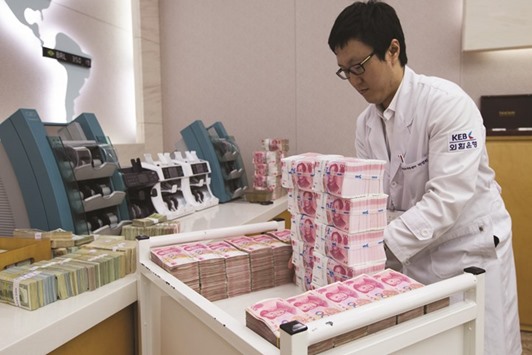The yuan sank to a five-year low after China’s central bank signalled it’s becoming more tolerant of a depreciating currency as intervention costs rise and economic growth slows.
The People’s Bank of China (PBoC) set the yuan’s daily reference rate at the lowest level since April 2011, weaker than Tuesday’s onshore closing level. The currency tumbled 1.1% in Hong Kong’s freely traded market - the most since the day after a surprise devaluation in August - and lost 0.6% in Shanghai as both exchange rates slumped to their weakest levels since at least March 2011. The gap between the two widened to a record.
While China’s defence of the yuan stabilised the currency for almost four months following the August 11 devaluation, intervention led to the first-ever annual decline in the nation’s foreign-exchange reserves. Official support has been more sporadic since the start of December as the weakest economic expansion in a quarter century and rising US interest rates fuelled capital outflows. Analysts at Macquarie Bank Ltd and Mizuho Bank said the PBoC’s exchange-rate policy is becoming harder to gauge.
“The market will be confused by what Beijing is trying to signal with the recent market intervention and today’s fixing,” said Nizam Idris, head of foreign-exchange and fixed-income strategy at Macquarie Bank in Singapore.
The central bank intervened in the currency market on Tuesday to prevent excessive volatility, said a person with direct knowledge of the matter. A few major Chinese banks sold US currency when the onshore yuan dropped to around 6.5460 per dollar yesterday, but the offerings weren’t stable or constant, according to traders who asked not to be named.
The offshore yuan dropped beyond 6.70 per dollar for the first time since September 2010, about two months after trading was first permitted in Hong Kong, while the onshore rate was 6.5560 as of 5:05 p.m. in Shanghai. The Hong Kong rate’s discount to the domestic level widened to a record 2.5%, after spreads of up to 1.8% triggered suspected PBoC intervention in the offshore market last week.
The central bank’s August devaluation, which sparked a rout in emerging-market currencies and stocks, was accompanied by a revamp of its methodology for setting the yuan’s daily fixing to give market forces greater sway. While allowing depreciation may help the Chinese economy, it risks spooking global markets, according to Japan’s Resona Bank.
“This isn’t good for the rest of the world,” said Koichi Kurose, Tokyo-based chief market strategist at Resona Bank. “Until China stops weakening the yuan, global markets will struggle to stabilise.
The Chinese authorities may be trying to prop up the economy by boosting exports, but while that will help one part of China’s economy, it comes at the sacrifice of someone else.”
Yuan swings tend to impact currencies and export prospects across Asia, with China being the biggest trading partner of economies including South Korea and Taiwan. The Bloomberg- JPMorgan Asia Dollar Index - which tracks the region’s 10 most- used currencies excluding the yen - reversed a daily gain immediately after the PBoC announced the cut to its yuan fixing and fell as much as 0.4%.
Government data next week is forecast to show Chinese exports shrank for a sixth straight month in December, according to the median estimate in a Bloomberg survey of economists. The private Caixin Media and Markit Economics Chinese services gauge fell to a 17-month low in December, according to a report released yesterday.
The yuan has “limited” room for further depreciation as slumping energy prices will help boost the current-account surplus in China, the world’s second-largest importer of oil, and offset capital outflows, according to Goldman Sachs Group.
Low crude prices may prop up the excess to about $360bn this year, a level last seen before the global financial crisis, analysts led by Robin Brooks wrote in a report on Tuesday.
A relatively strong export market compared to other developing nations also suggests the exchange rate is fairly valued, they said.
The PBoC cut its reference rate by 0.22% yesterday to 6.5314 per dollar, weaker than both Tuesday’s 4:30 pm level as well as the end-of-the-day rate. While onshore trading hours have been extended to 11:30 pm, the monetary authority has said it will continue to view the 4:30 pm price as the closing level. Authorities said in August they would use factors including the last closing level and movements in major currencies when setting the reference rate.
“The fixing today flags China’s policy risks,” said Ken Cheung, a Hong Kong-based strategist at Mizuho Bank. “It looks like that they set it in an arbitrary way and the mechanism is not consistent with their policy guidelines. This obviously undermines the PBoC’s policy credibility and investor confidence in the China market.”

An employee arranges Chinese one-hundred yuan banknotes at the Korea Exchange Bank headquarters in Seoul. The offshore yuan dropped beyond 6.70 per dollar for the first time since September 2010, about two months after trading was first permitted in Hong Kong, while the onshore rate was 6.5560 in Shanghai.
